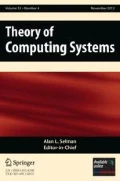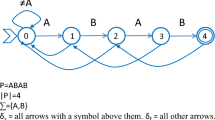Abstract
The concepts of power_index, satisfiability hypothesis (SH), and structure tree are introduced and used to make sharper hypotheses about a problem's complexity than “the problem isNP-complete.” These concepts are used to characterize the complexities of a number of basicNP-complete problems, including both CLIQUE and PARTITION which are shown to have power-indices at most 1/2. Also, the problem 3SAT is shown to be solvable deterministically in time exponential only in thesquare root ofv+c, wherev is the number of variables andc is the number of “crossovers” needed to layout the formula in the plane.
Similar content being viewed by others
References
S. Arnborg, J. Lagergren, and D. Seese, Which problems are easy for tree-decomposable graphs?, unpublished manuscript, 1987.
H. L. Bodlaender, Dynamic programming on graphs with bounded tree width, Technical Report RUU-CS-87-22, Dept. of Computer Science, University of Utrecht, Utrecht, The Netherlands, 1987.
S. A. Cook, The complexity of theorem-proving procedures,Proc. Third Annl. ACM Symp. on Theory of Computing, pp. 151–158, 1971.
S. A. Cook, Short propositional formulas represent nondeterministic computations,Inform. Process. Lett., vol. 26, pp. 269–270, 1988.
A. K. Dewdney, Linear time transformations between combinatorial problems,Internat. J. Comput. Math., vol. 11, pp. 91–110, 1982.
A. K. Dewdney, Generic reduction computers, Report No. 141, Dept. of Computer Science, University of Western Ontario, 1985.
M. R. Garey, R. L. Graham, and D. S. Johnson, SomeNP-complete geometric problems,Proc. 8th Ann. ACM Symp. on Theory of Computing, pp. 10–22, 1976.
M. R. Garey and D. S. Johnson,Computers and Intractability: A Guide to the Theory of NP-Completeness, Freeman, San Francisco, CA, 1979.
H. B. Hunt III, On the time and tape complexity of languages, Ph.D. dissertation, Dept. of Computer Science, Cornell University, Ithaca, NY, 1973.
H. B. Hunt III, S. S. Ravi, and R. E. Stearns, Separators, graphical homomorphisms, chromatic polynomials (extended Abstract),Proc. 26th Ann. Allerton Conf. on Communications, Control, and Computing, pp. 788–797, 1988.
H. B. Hunt III and R. E. Stearns, Nonlinear algebra and optimization on rings are “hard”,SICOMP, vol. 16, pp. 910–929, 1987.
H. B. Hunt III and R. E. Stearns, The complexity of very simple Boolean formulas with applications,SICOMP, vol. 19, pp. 44–70, 1990. Also appears as Technical Report TR 87-23, Dept. of Computer Science, SUNY at Albany, Albany, NY, 1987.
D. S. Johnson and C. H. Papadimitriou, Computational complexity, inThe Traveling Salesman Problem, ed. E. L. Lawler, J. K. Lenstra, A. H. G. Rinnooy Kan, and D. B. Shmoys, pp. 37–86, Wiley, New York, 1985.
R. M. Karp, reducibility among combinatorial problems, inComplexity and Computer Computations, ed. R. E. Miller and J. W. Thatcher, pp. 85–103, Plenum, New York, 1972.
R. L. Lipton and R. E. Tarjan, Applications of a planar separator theorem,SICOMP, vol. 9, pp. 615–629, 1980.
B. Monien and I. H. Sudborough,Bounding the Bandwidth of NP-Complete Problems, Lecture Notes in Computer Science, vol. 100, pp. 279–292, Springer Verlag, Berlin, 1981.
C. H. Papadimitriou, The Euclidean traveling salesman problem isNP-complete,Theoret. Comput. Sci., vol. 4, pp. 237–244, 1977.
S. S. Ravi and H.B. Hunt III, Application of planar separator theorem to counting problems,Inform. Process. Lett., vol. 25, pp. 317–321, 1987.
N. Robertson and P. D. Seymour, Graph minors II, algorithmic aspects of tree-width,J. Algorithms, vol. 7, pp. 309–322, 1986.
J. M. Robson, A new proof of theNP completeness of satisfiability,Proc. 2nd Australian Computer Science Conf. pp. 62–69, 1979.
J. M. Robson, Subexponential algorithms for someNP-complete problems, unpublished manuscript, 1985.
A. Rosenthal, Dynamic programming is optimal for nonserial optimization problems,SICOMP, vol. 11, pp. 47–59, 1982.
S. K. Sahni, Some subexponentially recognizableNP-complete languages, Technical Report 74-14, Computer Science Dept., University of Minnesota, 1974.
T. J. Schaefer, The complexity of satisfiability problems,Proc. 10th Ann. ACM Symp. on Theory of Computing, pp. 216–226, 1978.
C. P. Schnorr, Satisfiability is quasi-linear complete in NQL,J. Assoc. Comput. Mach., vol. 25, pp. 136–145, 1978.
R. E. Stearns and H. B. Hunt III, On the complexity of the satisfiability problem and the structure ofNP, Technical Report 86-21, Dept. of Computer Science, SUNY at Albany, Albany, NY, 1986.
R. E. Stearns and H. B. Hunt III, Power indices and easierNP-complete problems, Technical Report 88-27, Dept. of Computer Science, SUNY at Albany, Albany, NY, 1988.
R. E. Stearns and H. B. Hunt III, Structure trees and their application, Technical Report 90-2, Dept. of Computer Science, SUNY at Albany, Albany, NY, 1990.
L. J. Stockmeyer and A. R. Meyer, Word problems requiring exponential time,Proc. 5th Ann. ACM Symp. on Theory of Computing, pp. 1–9, 1973.
Author information
Authors and Affiliations
Additional information
The research of R. E. Stearns was supported by NSF Grants DCR 83-03932 and CCR 89-03319, and that of H. B. Hunt was supported by NSF Grants DCR 86-03184 and CCR 89-03319.
Rights and permissions
About this article
Cite this article
Stearns, R.E., Hunt, H.B. Power indices and easier hard problems. Math. Systems Theory 23, 209–225 (1990). https://doi.org/10.1007/BF02090776
Received:
Revised:
Issue Date:
DOI: https://doi.org/10.1007/BF02090776




